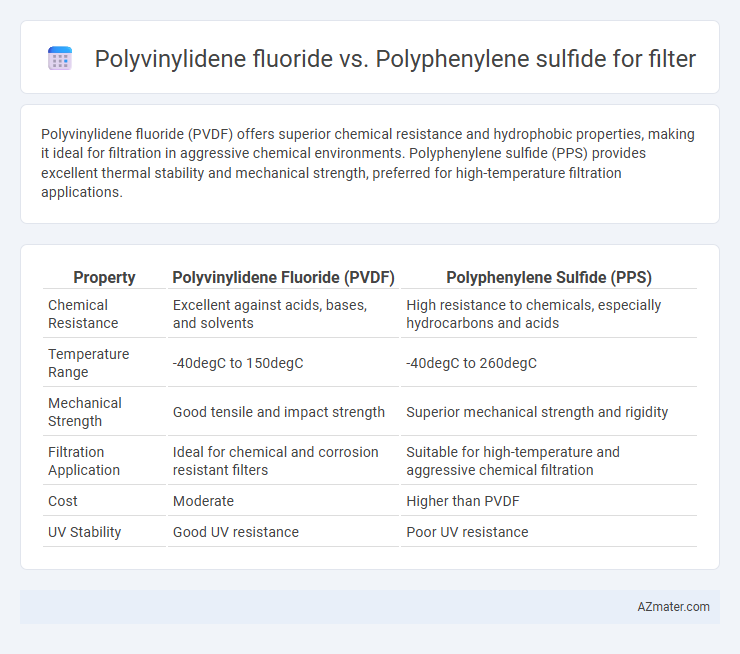Polyvinylidene fluoride (PVDF) offers superior chemical resistance and hydrophobic properties, making it ideal for filtration in aggressive chemical environments. Polyphenylene sulfide (PPS) provides excellent thermal stability and mechanical strength, preferred for high-temperature filtration applications.
Table of Comparison
| Property | Polyvinylidene Fluoride (PVDF) | Polyphenylene Sulfide (PPS) |
|---|---|---|
| Chemical Resistance | Excellent against acids, bases, and solvents | High resistance to chemicals, especially hydrocarbons and acids |
| Temperature Range | -40degC to 150degC | -40degC to 260degC |
| Mechanical Strength | Good tensile and impact strength | Superior mechanical strength and rigidity |
| Filtration Application | Ideal for chemical and corrosion resistant filters | Suitable for high-temperature and aggressive chemical filtration |
| Cost | Moderate | Higher than PVDF |
| UV Stability | Good UV resistance | Poor UV resistance |
Introduction to Polyvinylidene Fluoride (PVDF) and Polyphenylene Sulfide (PPS)
Polyvinylidene fluoride (PVDF) is a highly non-reactive and pure thermoplastic fluoropolymer with excellent chemical resistance, making it ideal for filtration applications requiring durability in aggressive environments. Polyphenylene sulfide (PPS) is a high-performance semicrystalline polymer known for its thermal stability, mechanical strength, and resistance to hydrolysis, often used in filter components exposed to high temperatures. Both materials offer distinct advantages in filtration technology: PVDF excels in chemical inertness and flexibility, while PPS provides superior thermal and mechanical performance.
Chemical Structure and Composition Comparison
Polyvinylidene fluoride (PVDF) features a semi-crystalline structure with repeating units of -(CH2-CF2)-, providing high chemical resistance and hydrophobicity ideal for filtration membranes. Polyphenylene sulfide (PPS) consists of aromatic rings linked by sulfur atoms, resulting in exceptional thermal stability and inherent chemical inertness suitable for harsh filtration environments. The fluorinated backbone of PVDF offers superior resistance to solvents and acids, while PPS's aromatic-sulfur composition delivers enhanced mechanical strength and resistance to high temperatures.
Mechanical Strength and Durability of PVDF vs PPS
Polyvinylidene fluoride (PVDF) exhibits higher mechanical strength with excellent impact resistance and flexibility, making it ideal for filters exposed to dynamic stresses. Polyphenylene sulfide (PPS) offers superior thermal stability and chemical resistance but tends to be more brittle, reducing its toughness under mechanical load. PVDF filters outperform PPS in durability during continuous mechanical cycling and abrasive environments.
Thermal Stability and Temperature Resistance
Polyvinylidene fluoride (PVDF) offers excellent thermal stability with a continuous service temperature of around 150degC, making it suitable for moderate heat filtration applications. Polyphenylene sulfide (PPS) exhibits superior temperature resistance, maintaining stability up to 260degC, ideal for high-temperature filtration processes. When selecting filters, PPS provides enhanced durability in extreme thermal environments compared to PVDF.
Chemical Resistance in Filtering Applications
Polyvinylidene fluoride (PVDF) offers outstanding chemical resistance to acids, bases, and solvents, making it ideal for filtering aggressive chemicals and maintaining membrane integrity in harsh environments. Polyphenylene sulfide (PPS) exhibits superior thermal stability and excellent resistance to hydrocarbons, oxidizing agents, and alkaline solutions, suitable for high-temperature filtration processes in the chemical and pharmaceutical industries. Choosing between PVDF and PPS depends on specific chemical exposure and temperature requirements, with PVDF favored for broad chemical resistance and PPS preferred for high-temperature stability and resistance to specific chemical classes.
Filtration Efficiency and Particle Retention
Polyvinylidene fluoride (PVDF) membranes exhibit superior filtration efficiency due to their exceptional chemical resistance, thermal stability up to 150degC, and high hydrophobicity, enhancing particle retention for submicron and nano-scale applications. Polyphenylene sulfide (PPS) filters, known for thermal stability up to 260degC and strong chemical durability, provide excellent mechanical strength but generally demonstrate slightly lower filtration efficiency compared to PVDF, especially for ultrafine particles. PVDF's finer pore size distribution and lower surface energy result in higher particle retention rates, making it the preferred choice for critical filtration processes requiring high purity and precise contaminant removal.
Hydrophobicity and Surface Properties
Polyvinylidene fluoride (PVDF) exhibits superior hydrophobicity with a water contact angle typically above 90deg, making it highly effective for water-repellent filter applications, whereas Polyphenylene sulfide (PPS) has moderate hydrophobicity with a contact angle around 80-85deg. PVDF's surface properties feature excellent chemical resistance and low surface energy, enhancing particle repellence and fouling resistance in filtration membranes. PPS offers robust thermal stability and mechanical strength but has a relatively higher surface energy, which can reduce its hydrophobic performance compared to PVDF in fluid filtration systems.
Cost Analysis: PVDF vs PPS Filters
Polyvinylidene fluoride (PVDF) filters generally exhibit higher initial material costs compared to polyphenylene sulfide (PPS) filters due to PVDF's superior chemical resistance and mechanical strength. PPS filters offer a more cost-effective solution for applications requiring moderate chemical resistance and elevated temperature performance, providing a lower price point with acceptable durability. Long-term operational costs favor PVDF filters in highly corrosive environments by reducing replacement frequency despite the upfront premium.
Applications in Different Filtration Industries
Polyvinylidene fluoride (PVDF) is favored in chemical, pharmaceutical, and water treatment filtration due to its excellent chemical resistance, thermal stability, and low moisture absorption. Polyphenylene sulfide (PPS) excels in automotive, fuel, and industrial air filtration environments where its high mechanical strength, thermal resistance, and dimensional stability under harsh conditions are critical. Both polymers offer exceptional filtration performance, but PVDF suits aggressive liquid filtration systems while PPS is preferred for demanding gas and particulate filtration applications.
Conclusion: Choosing the Right Material for Filter Use
Polyvinylidene fluoride (PVDF) offers superior chemical resistance and high purity, making it ideal for filters in aggressive chemical environments. Polyphenylene sulfide (PPS) provides outstanding thermal stability and mechanical strength, suited for high-temperature industrial filtration applications. Selecting the right filter material depends on the specific operational demands, such as chemical exposure and temperature range, ensuring optimal performance and durability.

Infographic: Polyvinylidene fluoride vs Polyphenylene sulfide for Filter
 azmater.com
azmater.com